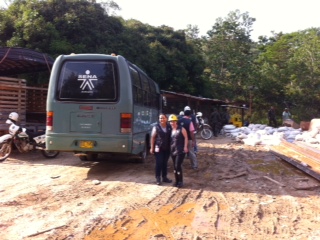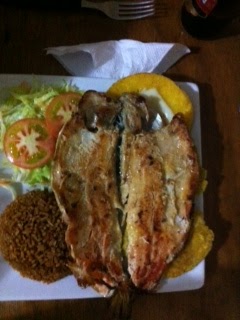On Tuesday March 5 we flew from the "old" smaller airport in Medellin to a place called Otun which is nearby two mining communities called Segovia and Remedios. We flew in an 18 seater plane made in Canada. Here are a few photos from that 30 minutes flight which saved us a 4-5 our drive:
A bird's view from part of the city of Medellin. I will make a post next weekend from this interesting city which last month was awarded the "most innovative city in the world 2013" beating New York City in the last round of nominations). Here a few photos from the flight and arrival in Otun:

We had a nice bus from SENA for our use these days in the area, and we had a local team of SENA instructors and coordinators accompanying us at the community stakeholder meetings and mine visits. We started with a meeting at the Segovia municipality:
Juan Guillermo, the sub-director for SENA in this region explained the Canadian project and how it hopes to increase the amount of training work SENA is already doing in the community. After an explanation of the local mining sector (first two photos above), we also had an excellent session on gender issues (with a few very passionate local gender mainstreaming champions):
A group of our delegation went into the mine-shaft (I took a rain-check this time). Here is the proud half-hour miners group after their short trip into the mine, sweating as if they just came out of a sauna
After this visit we drove to Remedios where we stayed two nights. A few photos of the communities we past through. Very rough. People live in relative poverty on top of so much "mineral wealth"
Sunset on the way back after a long day with a lot of impressions to process......
The next day we started with a community stakeholders session in the town-hall of Remedios:
Bibiana (with us from neighbouring province Bolivar) opened with some of the early experiences of our project in her province. The man in the wheel-chair is the city's chair of the city council; a miner who got injured years ago. When he spoke, there were words of wisdom of a person who never had the opportunity to go to school and who wants things to be better for the next generations. The mayor spoke a few words and did a good impromptu brainstorming session with Juan Guillermo who at the end of the session also did an excellent summary of the dynamics possible through our EFE program
Sandra from the SENA headquarters did another excellent presentation on gender and youth. And then we went for a visit to a local miner association. This company started 6 years ago basically as an illegal operation, but they now have a formal permit and they work hard on improving the quality of their production as well as reducing the environmental polution (according to the experts in our team they still have a long way to go on this though). Here is the main shift entrance. Just imagine this is right under the small town, even though it goes straigth down....
Next is a photo of the area where the miners prepare the explosives. Did not look to me like it was according to modern safety standards... Also a few photos of the bags full of rocks and one of the local mine dogs... a three legged one....
The rocks are transported up mechanically and this is already an improvement of the early years of this mine operation when the miners carried it up themselves. The miners who are not "associates" do not get paid a salary, but they get a percentage of the rocks they produce. They bring these rocks home and try to get the gold out of the rocks, of course all using mercury in their home or backyard. Not a good thing of course. The mine should move to just paying them a salary instead. The saddest part is the older and younger single women who are waiting in the area where the miners pick up their bags of rocks for "left over rocks", which they in turn also try to process at their homes.......
A few more photos of the newer part of this mine operation where they are now building a cleaner operation. However, in some of the photos you can see that the houses (mostly informal "invasion" houses of the poorer miners and others) are constructed right next to the plant...... not healthy....
Two proud graduates from SENA training programs in mine supervision and safety.
Does not look like a safe work practice does it... ? The visit caused many discussions among my colleagues of the SENA on-site and afterwards. So much to do to better train these workers...
And yes, we had some meals in between these meetings and mine visits. For those interested have a look at some of the plates. They are huge! But the miners do very hard physical work, sweat a lot in the heat (on average 35-40 degrees celcius) and need to eat well...
After these two days we went back to the Otun airport only to find the flight delayed a few hours, so more brainstorming on what could be done in one of the small places near the small airport:
One of the local donkeys wanted to give his opinion about it all as well....
Good bye Otun airport and Segovia & Remedios communities. Till a next time....
My next blog will show quite the difference with a clean mining operation full of good CSR work (Corporate Social Responsibility). Clean, responsible, safe and sustainable mining is possible....































































No comments:
Post a Comment